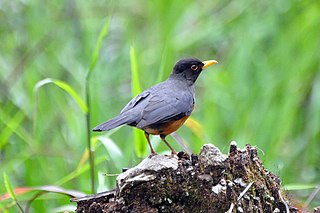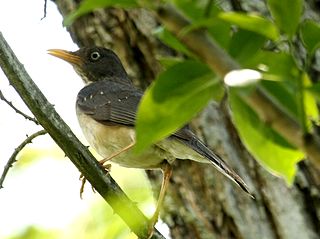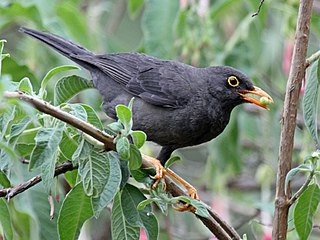The Taita thrush, also known as the Taita olive thrush or Heller's ground thrush, is an endangered bird from the family of thrushes (Turdidae), endemic to the Taita Hills in Kenya.

The Comoro blue pigeon is a species of bird in the family Columbidae. It is endemic to the Comoros and the coralline Seychelles. It is rated as a species of near threatened on the International Union for Conservation of Nature Red List of Endangered Species.

The white-crowned forktail is a species of forktail in the family Muscicapidae. Formally described in 1818, it has five subspecies, each occupying a different geographic range. The largest of the forktails, Enicurus leschenaulti, is between 25 and 28 centimetres long. It has a black throat and breast, black mantle, and largely black wings. The rump and lower back are white, and the bird has a prominent white crown, from which it gets its name. As with other forktails, the tail is long, deeply forked, and banded in black and white. A variety of whistling and clicking calls have been described. Slight morphological differences have been observed between subspecies.

The white-throated thrush is a species of bird in the family Turdidae. It is found in Mexico and Central America, ranging south to central Panama. This species has been referred to in some literature as "white-throated robin." However, that name is now more usually applied to the Old World species Irania gutturalis.

The Comoro thrush is a species of bird in the family Turdidae. It is found in the Comoros Islands in the south western Indian Ocean.

The grey-sided thrush is a species of bird in the thrush family, Turdidae.

The chestnut-bellied thrush is a species of bird in the family Turdidae. It is found in Colombia, Ecuador, Peru, and Venezuela. Its natural habitats are subtropical or tropical moist montane forests and heavily degraded former forest.

Hauxwell's thrush is a species of bird in the family Turdidae. It is found in Bolivia, Brazil, Colombia, Ecuador, Peru, and Venezuela.

The black thrush is a species of bird in the family Turdidae. It was formerly known as the black robin. It is found in El Salvador, Guatemala, Honduras, and Mexico. Its natural habitat is subtropical or tropical moist montane forest.

The white-eyed thrush is a species of bird in the family Turdidae that is endemic to Jamaica. Its natural habitats are subtropical or tropical moist lowland forests, subtropical or tropical moist montane forests, and heavily degraded former forest.

The Marañón thrush is a species of bird in the family Turdidae. It is found in far southern Ecuador and northern Peru. Its natural habitats are subtropical or tropical dry forests and subtropical or tropical moist lowland forests.

The Chinese thrush is a species of bird in the family Turdidae. It is found in China and far northern Vietnam. Its natural habitats are temperate forests and subtropical or tropical moist montane forests.

The pale-vented thrush is a species of bird in the family Turdidae.

The São Tomé thrush or olivaceous thrush is a species of bird in the family Turdidae. It is endemic to São Tomé. Until 2010, the related Príncipe thrush was considered a subspecies, Turdus olivaceofuscus xanthorhynchus.

The black-hooded thrush is a species of bird in the family Turdidae. It is mainly found in Venezuela and in certain parts of Colombia. Its natural habitats are subtropical or tropical moist montane forests, subtropical or tropical high-altitude shrubland, and heavily degraded former forest.

The red-legged thrush is a species of bird in the family Turdidae. Native to the Caribbean, it is found in the Bahamas, Cayman Islands, Cuba, Dominica, Hispaniola and Puerto Rico. It formerly occurred on the Swan Islands, Honduras, but was extirpated there.

The plumbeous-backed thrush is a species of bird in the family Turdidae. It is found in Ecuador and Peru. Its natural habitats are subtropical or tropical dry forests, subtropical or tropical moist lowland forests, and subtropical or tropical moist montane forests.

The glossy-black thrush is a species of bird in the family Turdidae. It is found from northern Venezuela to northwestern Argentina. Its natural habitat is subtropical or tropical moist montane forests.

The La Selle thrush is a species of bird in the family Turdidae endemic to the Caribbean island of Hispaniola. A skulker of broadleaf and pine forests around 1300m, it is limited to a small and declining population in the inland Dominican Republic, as well as a relict population in Haiti.

The Príncipe thrush is a species of bird in the family Turdidae. It is endemic to Príncipe. It was formerly considered a subspecies of the São Tomé thrush, with some taxonomists still considering it so.






















